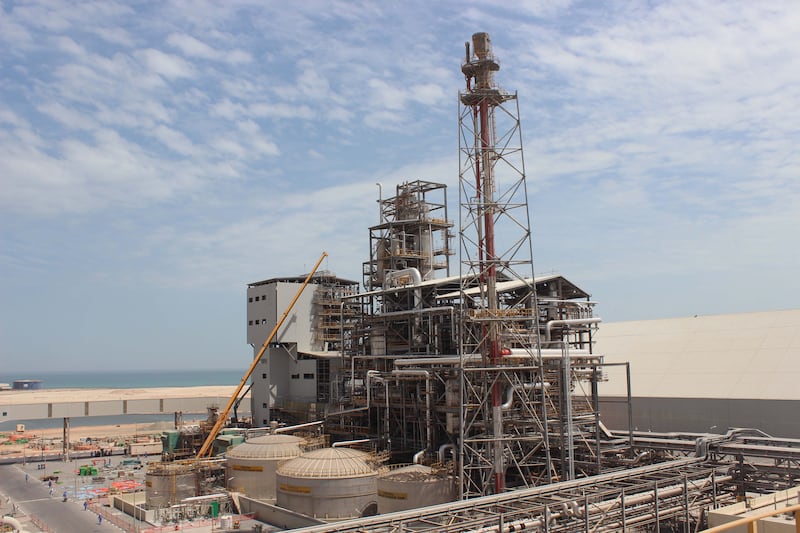The Abu Dhabi International Petroleum Exhibition and Conference (Adipec), held last week, is one of the world’s largest oil and gas events. So it was curious that about half of the discussion at the event revolved around non-oil topics – particularly, hydrogen, carbon capture and the circular economy. Is this focus an indication of the emergence of a new type of energy company?
In the late 1990s, internet-savvy gas and electricity marketer Enron, not yet exposed as a fraud, was the envy of the slow-moving dinosaurs of the “old economy”. Shell, Chevron and the other major oil firms toyed with the idea that they were really energy companies, agnostic as to source or form. Shell set up an electricity joint venture called InterGen. In July 2000, BP suggested that it was no longer “British Petroleum” and that its initials really stood for “Beyond Petroleum”.
Most of them invested in some way in renewables, then a small sector dependent on government subsidies. Even monomaniac ExxonMobil tinkered with biofuels made from algae. Ultimately, they discovered that they were too early, or that their traditional business models did not work in these novel sectors. Most of the electricity and renewable businesses were sold off at heavy losses or quietly downscaled.
The same branding seems fashionable today: TotalEnergies, Qatar Energy and Energy Development Oman are recent changes of name. And outside North America, the big oil companies are very active in solar, wind, electric vehicle charging networks, electricity retail and other potential future winners.
Renewables and battery cars are certainly far more mature than they were in the early 2000s – indeed, they are already the lowest-cost technology in many cases. But the other challenges for oil companies remain.
The cynic might observe that oil and gas companies are still developing a lot of hydrocarbons; they just aren’t trumpeting it as much. The chief executive of TotalEnergies, Patrick Pouyanne, has said: “I'm proud to be black and green, because if I don't have the black part, which is delivering cash flows, I don't have the green part.”
Electricity generation is a heavily regulated business with safe but low returns. Renewable development has become cut-throat, as seen in accusations that BP overpaid for wind farm licences in February.
Outside a few areas, such as energy trading, it is hard to see where legacy oil companies have an advantage over experienced and well-capitalised renewable-focused players such as Engie, Iberdrola and Enel. And, even in offshore wind, which seems like a natural domain for North Sea oil companies, there are well-established experts such as Denmark’s Ørsted.
The largest American petroleum corporations, such as ExxonMobil, Chevron, ConocoPhillips and Occidental, have mostly eschewed renewables, except for biofuels, which fit with fuel distribution and are often required by law. And, the state oil companies, stewards of the national resource wealth, cannot choose to exit hydrocarbons.
So if not energy companies, what can state or private oil companies become to enjoy a long-term future in a world taking action against climate change? The conversations at Adipec may be part of the answer.
A legacy revolving around hydrocarbons can become a future centred on the components – hydrogen and carbon.
Hydrogen has emerged over the past year as a magic fuel – combusting to leave only water, it can be the clean energy carrier for industry, ships and planes. It can be made from natural gas with carbon capture and storage (“blue” hydrogen) or “green” hydrogen from renewable energy.
Its transformations into useful derivatives such as ammonia, methanol and synthetic fuels are already the stock-in-trade of oil companies.
So it can readily become part of their core business. Adnoc has already shown its keenness with a range of projects and announcements, most recently the joint venture with Taqa for green hydrogen globally.
Carbon seems less clear. Indeed, carbon dioxide release from burning oil and gas is the industry’s Achilles heel.
But carbon itself is also a gigantic business opportunity. First, there is the task of reducing emissions from large, stationary sites such as power plants, refineries and heavy industry. Carbon dioxide can even be imported from countries that lack suitable geology or policy to capture it themselves, such as South Korea, Japan and Germany.
Oil companies such as Shell, TotalEnergies and Equinor are central players in carbon capture hubs being developed around the North Sea. The UAE, too, could consider four clusters: Habshan-Ruwais, Mussaffah-Abu Dhabi-Taweelah, Jebel Ali-Dubai-Sharjah, and Ras Al Khaimah-Fujairah.
Second, even to come close to climate goals, it will be necessary to remove enormous quantities of carbon dioxide directly from the air. By late this century, direct air capture (DAC) of 30 billion tonnes annually would scale up the current carbon capture industry by a thousand times. This will reverse two centuries of climate damage and offset remaining unavoidable emissions.
And third, to make climate-neutral synthetic fuels, likely to be essential for aviation, it will be necessary to use atmospheric instead of fossil carbon – whether from DAC or biological methods.
By about 2050, hydrogen may be a $1 trillion annual business; carbon management, $2tn. That compares to the present-day oil business with about $3tn of yearly revenue.
This is not to say that oil majors cannot make a success of electricity and renewables, and integrate them into their existing businesses. Indeed, in the form of green hydrogen, that will be essential. But there is a more natural fit for their skills and assets: their ability to mobilise capital and manage large, complex integrated projects, as well as their expertise in geological uncertainty. Not energy companies, not hydrocarbon corporations, but carbon-hydrogen champions.
Robin M. Mills is CEO of Qamar Energy, and author of The Myth of the Oil Crisis







